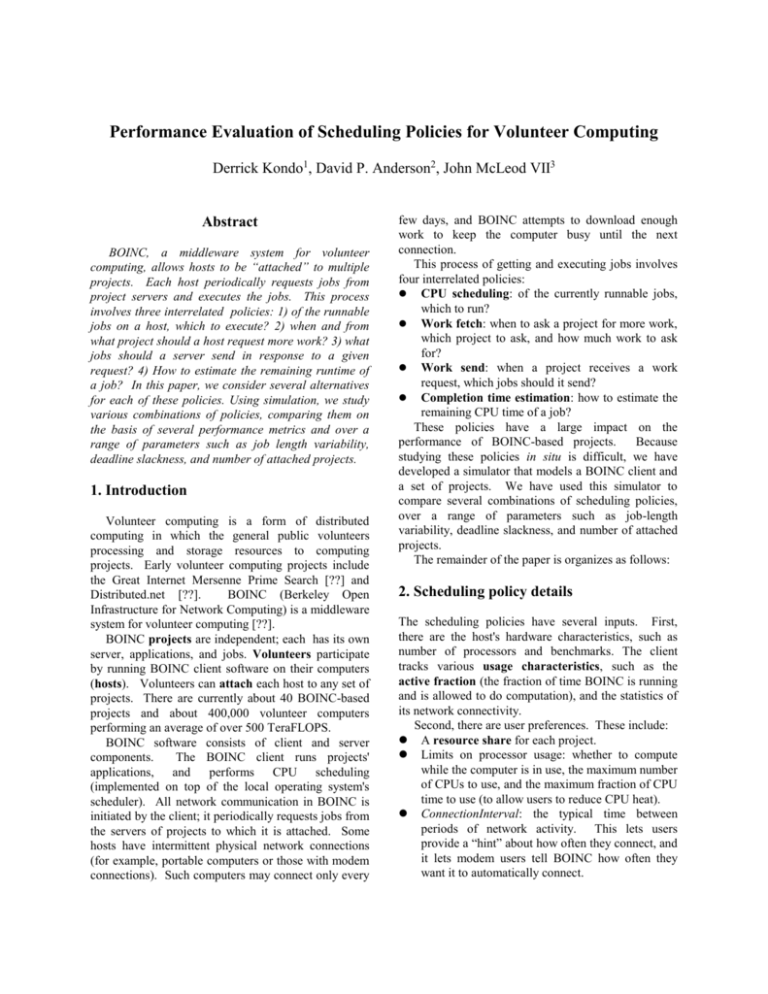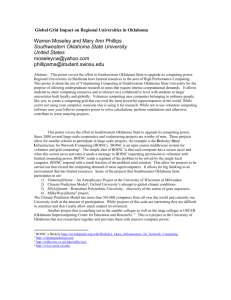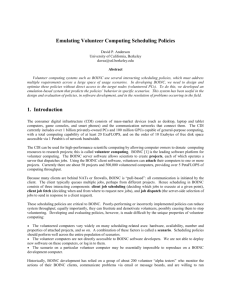intro
advertisement

Performance Evaluation of Scheduling Policies for Volunteer Computing Derrick Kondo1, David P. Anderson2, John McLeod VII3 Abstract BOINC, a middleware system for volunteer computing, allows hosts to be “attached” to multiple projects. Each host periodically requests jobs from project servers and executes the jobs. This process involves three interrelated policies: 1) of the runnable jobs on a host, which to execute? 2) when and from what project should a host request more work? 3) what jobs should a server send in response to a given request? 4) How to estimate the remaining runtime of a job? In this paper, we consider several alternatives for each of these policies. Using simulation, we study various combinations of policies, comparing them on the basis of several performance metrics and over a range of parameters such as job length variability, deadline slackness, and number of attached projects. 1. Introduction Volunteer computing is a form of distributed computing in which the general public volunteers processing and storage resources to computing projects. Early volunteer computing projects include the Great Internet Mersenne Prime Search [??] and Distributed.net [??]. BOINC (Berkeley Open Infrastructure for Network Computing) is a middleware system for volunteer computing [??]. BOINC projects are independent; each has its own server, applications, and jobs. Volunteers participate by running BOINC client software on their computers (hosts). Volunteers can attach each host to any set of projects. There are currently about 40 BOINC-based projects and about 400,000 volunteer computers performing an average of over 500 TeraFLOPS. BOINC software consists of client and server components. The BOINC client runs projects' applications, and performs CPU scheduling (implemented on top of the local operating system's scheduler). All network communication in BOINC is initiated by the client; it periodically requests jobs from the servers of projects to which it is attached. Some hosts have intermittent physical network connections (for example, portable computers or those with modem connections). Such computers may connect only every few days, and BOINC attempts to download enough work to keep the computer busy until the next connection. This process of getting and executing jobs involves four interrelated policies: CPU scheduling: of the currently runnable jobs, which to run? Work fetch: when to ask a project for more work, which project to ask, and how much work to ask for? Work send: when a project receives a work request, which jobs should it send? Completion time estimation: how to estimate the remaining CPU time of a job? These policies have a large impact on the performance of BOINC-based projects. Because studying these policies in situ is difficult, we have developed a simulator that models a BOINC client and a set of projects. We have used this simulator to compare several combinations of scheduling policies, over a range of parameters such as job-length variability, deadline slackness, and number of attached projects. The remainder of the paper is organizes as follows: 2. Scheduling policy details The scheduling policies have several inputs. First, there are the host's hardware characteristics, such as number of processors and benchmarks. The client tracks various usage characteristics, such as the active fraction (the fraction of time BOINC is running and is allowed to do computation), and the statistics of its network connectivity. Second, there are user preferences. These include: A resource share for each project. Limits on processor usage: whether to compute while the computer is in use, the maximum number of CPUs to use, and the maximum fraction of CPU time to use (to allow users to reduce CPU heat). ConnectionInterval: the typical time between periods of network activity. This lets users provide a “hint” about how often they connect, and it lets modem users tell BOINC how often they want it to automatically connect. SchedulingInterval: the “time slice” of the BOINC client CPU scheduler (the default is one hour). WorkBufAdditional: how much work to buffer beyond ConnectionInterval. Finally, each job has a number of project-specified parameters, including estimates of its number of floating-point operations, and a deadline by which it should be reported. Most BOINC projects use replicated computing, in which two or more instances of each job are processed on different hosts. If a host doesn’t return a job by its deadline, the user is unlikely to receive credit for the job. We will study two or three variants of each policy, as described below. 2.1) CPU scheduling policies CS1: Round-robin time-slicing between projects, weighted according to their resource share. CS2: Do a simulation of weighted round-robin scheduling, identifying jobs that will miss their deadlines. Schedule such jobs earliest deadline first. If there are remaining CPUs, schedule other jobs using weighted round-robin. 2.4) Job completion estimation policies JC1: BOINC applications report their fraction done periodically during execution. The reliability of an estimate based on fraction done presumably increases as the job progresses. Hence, for jobs in progress BOINC uses the estimate FA + (1-F)B where F is the fraction done, A is the estimate based on elapsed CPU time and fraction done, and B is the estimate based on benchmarks, floating-point count, user preferences, and CPU efficiency (the average ratio of CPU time to wall time for this project). JC2: Maintain a per-project duration correction factor, an estimate of the ratio of actual CPU time to originally estimated CPU time. This is calculated in an conservative way; increases are reflected immediately, but decreases are exponentially smoothed. JC3: The mean and standard deviation of the ratio of actual to estimated CPU time are maintained. For work fetch, the mean is used; for CPU scheduling, the mean plus 2-3 standard deviations is used. The idea is to be slightly aggressive about fetching work, and slightly conservative about scheduling it. 3. Scheduling scenarios 2.2) Work fetch policies WF1: keep enough work queued to last for ConnectionInterval+WorkBufAdditional, and divide this queue between projects based on resource share, with each project always having at least one job running or queued. WF2: Maintain the “long term debt” of work owed to each project. Use simulation of weighted roundrobin to estimate its CPU shortfall. Fetch work from the project for which debt – shortfall is greatest. Avoid fetching work repeatedly from projects with tight deadlines. The details of this policy are given in [??]. 2.3) Work send policies WS1: given a request for X seconds of work, send a set of jobs whose estimated run times (based on FLOPS estimates, benchmarks, etc.) are at least X. WS2: the request message includes a list of all jobs in progress on the host, including their deadlines and completion times. For each “candidate” job J, do an EDF simulation of the current workload with J added. Send J only if it meets its deadline, all jobs that currently meet their deadlines continue to do so, and all jobs that miss their deadlines don’t miss them by more. Our simulator allows specification of the following parameters: Host hardware characteristics: number of CPUs and CPU speed. Minimum time between network connections Host availability CPU scheduling interval ConnectionInterval, WorkBufAdditional Number of projects, and for each project the following: Resource share Latency bound Job FLOPs estimate Job FLOPs actual distribution (normal) Each combination of parameters is called a scenario. We have used the simulator to do two types of experiments: 1. Compare different policies over a fixed distribution of scenarios. We have done this using distributions in which each parameter is chosen from a uniform distribution, selected to approximate the real world. One could also use distributions intended to project the state of the real world at some point in the future. 2. Fix all parameters but one, and vary that parameter of a range of plausible values. This is useful for identifying the situations where a particular scheduling policy performs poorly. 4. Performance metrics We use the following metrics in evaluating scheduling policies: 1. Idleness: of the total available CPU time, the fraction that is unused because there are no runnable jobs. This is in [0..1], and is ideally zero. 2. Waste: of the CPU time that is used, the fraction used by jobs that miss their deadline. 3. Share violation: a measure of how closely the user’s resource shares were respected, where 0 is best and 1 is worst. 4. Monotony: an inverse measure of how often the host switches between projects: 0 is as often as possible (given the scheduling interval and other factors) and 1 means there is no switching. This metric represents the fact that if a volunteer has devoted equal resource share to two projects, and sees his computer running only one of them for a long period, he will be dissatisfied.











